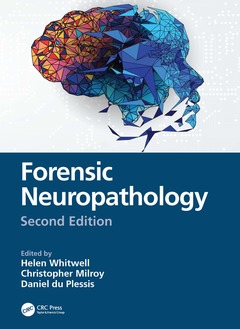Description
Forensic Neuropathology (2nd Ed.)
Coordinators: Whitwell Helen, Milroy Christopher, du Plessis Daniel
Language: English
Subjects for Forensic Neuropathology:
Keywords
Anterior Cerebral Artery Aneurysms; Traumatic brain injury; Spontaneous Subarachnoid Haemorrhage; Forensic neuropathologists; Head Injuries; Forensic neuropathology; Diffuse Traumatic Axonal Injury; Neurosurgeons; SUDEP; Forensic pathologists; Subdural Haematoma; Traumatic Axonal Injury; Contusional Injury; Spinal Cord; ASDH; Skull Fractures; Hypoxic Ischaemic Damage; Axonal Injury; Non-accidental Head Injury; Internal Carotid Arteries; Contrecoup Contusion; Decompressive Craniectomy; Diffuse Axonal Injury; Subdural Hygromas; Hard Palate; Falx Cerebri; Medico Legal Setting; Superior Sagittal Sinus; CAA
· 21x28 cm · Hardback
Description
/li>Contents
/li>Readership
/li>Biography
/li>
Forensic neuropathology is an important specialty within forensic pathology. In addition to traumatic brain injury in the adult and child, forensic neuropathologists must also consider the role of natural disease within the forensic setting such as cerebrovascular disease, as well as neurotoxicology. Focusing on difficulties that arise in the medico-legal context, the chapters include techniques for the post-mortem examination of the brain and related structures. Forensic pathologists, neuropathologists, general pathologists, clinical forensic specialists as well as neuroscientists, neurologists and neurosurgeons will all find useful information. In addition, members of the legal profession have found this an important reference work.
Chapters have been extensively revised and new content includes
- Chronic traumatic encephalopathy-related pathology
- Sudden unexplained death in epilepsy
- Biomechanics of head injury
- Updates on pathological aspects of head injury including infant head injury with ocular pathology
- Clinical aspects of head injury and spinal injury including a new chapter on neuroradiology
Reviews of the First Edition
This outstanding book is unique. Well-illustrated with high-quality colour photographs and line drawings, it reads well. Strongly recommended for trainees in histopathology, neuropathology, paediatric pathology, and forensic pathology, as well as for consultants practising in these fields.
1. Anatomy of the head and neck. 2. Clinical aspects of head injury. 3. Imaging of head trauma. 4. Biomechanics of primary traumatic head injury. 5. Techniques. 6. Scalp, facial and gunshot injuries. 7. Adult skull fractures. 8. Intracranial haematomas – Extradural and subdural. 9. Subarachnoid haemorrhage and cerebrovascular traumatic pathology. 10. Contusional brain injury and intracerebral haemorrhage - Traumatic and non-traumatic. 11. Traumatic axonal injury. 12. Brain swelling, raised intracranial pressure and hypoxia-related brain injury. 13. Sudden unexpected death in epilepsy. 14. Contact sport and blast-related neuropathology. 15. Head injury in the child. 16. Spinal injuries. 17. Difficult areas in forensic pathology: Homicide, suicide or accident. 18. Non-traumatic neurological conditions in medico-legal work. 19. Alcohol, drugs, toxins and post-mortem toxicology. 20. The role of the expert witness.
Helen Whitwell, Formerly Professor of Forensic Pathology, University of Sheffield; and Neuropathologist, West Midlands, UK
Christopher Milroy, Forensic Pathologist and Professor, Department of Pathology and Laboratory Medicine, University of Ottawa, Canada
Daniel du Plessis, Consultant Neuropathologist, Neuropathology Unit, Department of Cellular Pathology; and Greater Manchester Clinical Neurosciences Centre, Salford Royal Hospital NHS Foundation Trust, Liverpool, UK
These books may interest you

Developmental Neuropathology 256.96 €

Forensic Neuropathology 196.56 €

Forensic Neuropathology 129.87 €

